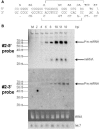Prediction and identification of herpes simplex virus 1-encoded microRNAs
- PMID: 16699030
- PMCID: PMC1472173
- DOI: 10.1128/JVI.00200-06
Prediction and identification of herpes simplex virus 1-encoded microRNAs
Abstract
MicroRNAs (miRNAs) are key regulators of gene expression in higher eukaryotes. Recently, miRNAs have been identified from viruses with double-stranded DNA genomes. To attempt to identify miRNAs encoded by herpes simplex virus 1 (HSV-1), we applied a computational method to screen the complete genome of HSV-1 for sequences that adopt an extended stem-loop structure and display a pattern of nucleotide divergence characteristic of known miRNAs. Using this method, we identified 11 HSV-1 genomic loci predicted to encode 13 miRNA precursors and 24 miRNA candidates. Eight of the HSV-1 miRNA candidates were predicted to be conserved in HSV-2. The precursor and the mature form of one HSV-1 miRNA candidate, which is encoded approximately 450 bp upstream of the transcription start site of the latency-associated transcript (LAT), were detected during infection of Vero cells by Northern blot hybridization. These RNAs, which behave as late gene products, are not predicted to be conserved in HSV-2. Additionally, small RNAs, including some that are roughly the expected size of precursor miRNAs, were detected using probes for miRNA candidates derived from sequences encoding the 8.3-kilobase LAT, from sequences complementary to U(L)15 mRNA, and from the region between ICP4 and U(S)1. However, no species the size of typical mature miRNAs were detected using these probes. Three of these latter miRNA candidates were predicted to be conserved in HSV-2. Thus, HSV-1 encodes at least one miRNA. We hypothesize that HSV-1 miRNAs regulate viral and host gene expression.
Figures






Similar articles
-
Characterization of herpes simplex virus 2 primary microRNA Transcript regulation.J Virol. 2015 May;89(9):4837-48. doi: 10.1128/JVI.03135-14. Epub 2015 Feb 11. J Virol. 2015. PMID: 25673716 Free PMC article.
-
Numerous conserved and divergent microRNAs expressed by herpes simplex viruses 1 and 2.J Virol. 2010 May;84(9):4659-72. doi: 10.1128/JVI.02725-09. Epub 2010 Feb 24. J Virol. 2010. PMID: 20181707 Free PMC article.
-
Novel less-abundant viral microRNAs encoded by herpes simplex virus 2 latency-associated transcript and their roles in regulating ICP34.5 and ICP0 mRNAs.J Virol. 2009 Feb;83(3):1433-42. doi: 10.1128/JVI.01723-08. Epub 2008 Nov 19. J Virol. 2009. PMID: 19019961 Free PMC article.
-
Herpes Simplex Virus 1 MicroRNAs: An Update.Intervirology. 2023;66(1):97-110. doi: 10.1159/000531348. Epub 2023 Jun 7. Intervirology. 2023. PMID: 37285807 Free PMC article. Review.
-
Are miRNAs critical determinants in herpes simplex virus pathogenesis?Microbes Infect. 2018 Oct-Nov;20(9-10):461-465. doi: 10.1016/j.micinf.2017.12.007. Epub 2017 Dec 26. Microbes Infect. 2018. PMID: 29287990 Free PMC article. Review.
Cited by
-
Characterization of herpes simplex virus 2 primary microRNA Transcript regulation.J Virol. 2015 May;89(9):4837-48. doi: 10.1128/JVI.03135-14. Epub 2015 Feb 11. J Virol. 2015. PMID: 25673716 Free PMC article.
-
Host-virus interaction: a new role for microRNAs.Retrovirology. 2006 Oct 11;3:68. doi: 10.1186/1742-4690-3-68. Retrovirology. 2006. PMID: 17032463 Free PMC article. Review.
-
Prediction of viral microRNA precursors based on human microRNA precursor sequence and structural features.Virol J. 2009 Aug 20;6:129. doi: 10.1186/1743-422X-6-129. Virol J. 2009. PMID: 19691855 Free PMC article.
-
Small Noncoding RNA (sncRNA1) within the Latency-Associated Transcript Modulates Herpes Simplex Virus 1 Virulence and the Host Immune Response during Acute but Not Latent Infection.J Virol. 2022 Apr 13;96(7):e0005422. doi: 10.1128/jvi.00054-22. Epub 2022 Mar 7. J Virol. 2022. PMID: 35254102 Free PMC article.
-
RETRACTED: HBV-encoded miR-2 functions as an oncogene by downregulating TRIM35 but upregulating RAN in liver cancer cells.EBioMedicine. 2019 Oct;48:117-129. doi: 10.1016/j.ebiom.2019.09.012. Epub 2019 Sep 14. EBioMedicine. 2019. Retraction in: EBioMedicine. 2021 Oct;72:103667. doi: 10.1016/j.ebiom.2021.103667. PMID: 31530503 Free PMC article. Retracted.
References
Publication types
MeSH terms
Substances
Grants and funding
LinkOut - more resources
Full Text Sources
Other Literature Sources
Research Materials

